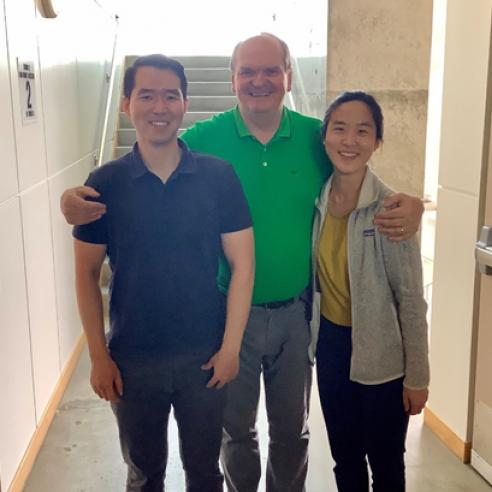3-D Map of the Brain Will Help Eye Researchers
 Alessandra Angelucci (right), a University of Utah professor of ophthalmology and visual science, and University of Utah computer science professor Valerio Pascucci stand in front of a computer model of a cluster of neurons scanned from a primate's brain.
Alessandra Angelucci (right), a University of Utah professor of ophthalmology and visual science, and University of Utah computer science professor Valerio Pascucci stand in front of a computer model of a cluster of neurons scanned from a primate's brain.
The animal brain is so complex, it would take a supercomputer and vast amounts of data to create a detailed 3-D model of the billions of neurons that power it.
But computer scientists and an RPB-supported professor of ophthalmology at the University of Utah have developed software that maps out a monkey's brain and more easily creates a three-dimensional model, providing a more complete picture of how the brain is wired.
"If you understand how things are wired in the normal brain, you can use this as a basis to understand how these connections are disrupted in the abnormal brain," said Alessandra Angelucci, professor of ophthalmology and visual science at the University of Utah.
Getting a more accurate view of the brain's network of neurons can help medical researchers understand how the brain's connectivity is disrupted in mental and neurological conditions such as schizophrenia, depression, anxiety and autism. For Angelucci, who works at the University of Utah's Moran Eye Center, this also can aid research on such vision-related conditions as amblyopia, a disorder where one or both eyes lack visual acuity, and various forms of retinal degeneration. Angelucci has been using this software on a monkey's brain because it most closely resembles the human brain.
In the past, researchers would have to scan thousands of thin layers of a primate's brain through a microscope in order to get a view of its neurons, the brain's cells that transmit nerve impulses. There was no practical way to make a three-dimensional model of the brain from these layers. For example, a high-resolution scan of a part of the brain the size of a penny would generate about two million images all totaling 30 terabytes (30,000 gigabytes) in files.
"It takes a lot of computer power because we now have to reconstruct a three-dimensional image out of this — thousands and thousands of images of tissue," Angelucci said. "It was simply impossible because there is no computer or software that can handle that. It involves terabytes and terabytes of data."
Partnership with School of Computing
A team led by Valerio Pascucci, a professor in the University of Utah's School of Computing and director of the university's Center for Extreme Data Management Analysis and Visualization (CEDMAV) at the Scientific Computing and Imaging Institute (SCI), has developed software that can create a 3-D model of an animal's brain that is much quicker and requires less computer power and system memory.
The team took an existing software platform CEDMAV created called VISUS (Visualization Streams for Ultimate Scalability) and adapted it to assemble high-resolution images of different sections of the brain into one 3-D model that can be viewed at different angles. VISUS is used to visualize huge sets of data to create weather or energy simulations or high-resolution images of cities.
With the new software, hundreds of 3-D blocks of the brain are then scanned one at a time with a two-photon microscope, and scientists can view the scans immediately as opposed to waiting for them to download.
What the 3D Model Means for Research
With the help of a researcher, the software then can more easily and quickly assemble the blocks into one complete picture of a region of the brain and create a 3-D model that allows the scientist to view areas and angles that couldn't be seen as easily with 2-D images. In this way, researchers can map out the individual neurons and their long tails, known as axons.
"It really unleashes a different level of understanding of the data itself — being able to look at something fully in 3-D and to rotate and look at in front and in back," Pascucci said. "We have seen over and over in many fields that this makes people understand more quickly and much better the spatial relationship among all the parts."
With the software, researchers also can monitor the scanning of the brain — which can take weeks — and make sure that no bad images are created in the process, saving precious time.
Thanks to this new tool, medical researchers can now study and better understand how the brain's connectivity is disrupted in abnormal conditions, for example what happens to the brain's neural network resulting from retinal degeneration or conditions such as autism.
"We can view it, reconstruct it and understand its connectivity," Angelucci said. "This software speeds up our ability to do that."
Also working with Pascucci on the software is master's students Cameron Christensen and Mike Liu, graduate research assistant Duong Hoang, and SCI senior engineer Giorgio Scorzelli. Working with Angelucci is Frederick Federer, a senior postdoctoral fellow. The research was supported by funds from the National Institutes of Health, the National Science Foundation, and Research to Prevent Blindness.
October 28, 2015
Related News: Amblyopia, Neuro-Ophthalmology, Retina Disorders

Research to Prevent Blindness and Association of University Professors of Ophthalmology Announce 2025 Recipient of RPB David F. Weeks Award for Outstanding Vision Research
Maria Bartolomeo Grant, MD, is recognized for ground-breaking contributions to the field of vision research.

Research to Prevent Blindness Announces New Sight-Saving Vision Research Grants
RPB launches awards in data science and Diabetic Eye Disease.

Research to Prevent Blindness Marks $400 Million in Funding to Advance Eye Disease Research
RPB funds a new round of researchers and hits a milestone in supporting vision-related breakthroughs.

An RPB Awardee Tackles Inherited Retinal Diseases
Dr. Krzysztof Palczewski develops and applies cutting-edge gene editing techniques to challenging genetic conditions.

Research to Prevent Blindness and Association of University Professors of Ophthalmology Announce 2022 Recipient of RPB David F. Weeks Award for Outstanding Vision Research
Donald Zack, MD, PhD, is recognized for ground-breaking contributions to the field of vision research.
Subscribe
Get our email updates filled with the latest news from our researchers about preventing vision loss, treating eye disease and even restoring sight. Unsubscribe at any time. Under our privacy policy, we'll never share your contact information with a third party.
| General Info | Grants | News & Resources |




